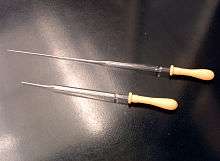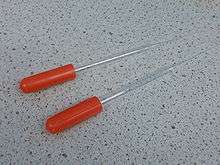Pasteur pipette


Pasteur pipettes, also known as droppers or eye droppers, are used to transfer small quantities of liquids.[1] They are usually glass tubes tapered to a narrow point, and fitted with a rubber bulb at the top. The combination of the Pasteur pipette and rubber bulb has also been referred to as a teat pipette. Pasteur pipettes come in various lengths and are sold in boxes of hundreds. They are named after the French scientist Louis Pasteur, who was known to have used a variant of them extensively during his research. Generally, they are considered cheap enough to be disposable, however, so long as the glass point is not chipped, the Pasteur pipette may be washed and reused indefinitely.
The name eye dropper also may refer to early models of fountain-pens, which have to be refilled with some kind of Pasteur pipette.
Plastic Pasteur pipettes
Plastic Pasteur pipettes, also referred to as transfer pipettes, have their stems and bulbs in the form of a single piece made of plastic. There are different sizes. The volumes are usually marked on the stem, though the markings are rather crude and are not particularly accurate.
Plastic Pasteur pipettes are often used in biology where most media are aqueous, and solvent resistance is not important. Most organic solvents, such as hexane and acetone, cannot be used in plastic Pasteur pipettes. They dissolve the plastic in these instruments, rendering them inadequate for many types of applications. The pipettes are also hard to wash, and are usually discarded with other biohazard waste after each use.
Plastic bulb pipettes are generally not precise enough to be used for exact measurements, whereas their glass counterparts can be extremely precise. The longer and thinner the tip of a glass pipette, the more exact the measurement. Usually they will be used in conjunction with a scale.
Microscale use

The constriction toward the tip of the Pasteur pipettes may be plugged with a bit of tissue paper or cotton wool to filter off solids from small amounts of liquids. The use of celite is optional. The bulb can be attached and squeezed to help viscous solutions filter more rapidly.
With a bit of skill, Pasteur pipettes may also be used for microscale column chromatography. With appropriately fine silica gel, the bulb may be squeezed for microscale flash column chromatography.[2]
Pasteur pipettes can also be used for microscale distillations. The liquid to be distilled is placed into a small reaction tube along with a boiling chip and heated to reflux one-half to two-thirds of the way up the inside of the tube. After squeezing the bulb to expel air, a pasteur pipette is inserted into the tube just below the level of the ring of refluxing liquid (into the vapor). The vapor is then drawn into the relatively cold pipette tip, causing it to condense and accumulate inside of the pipette.